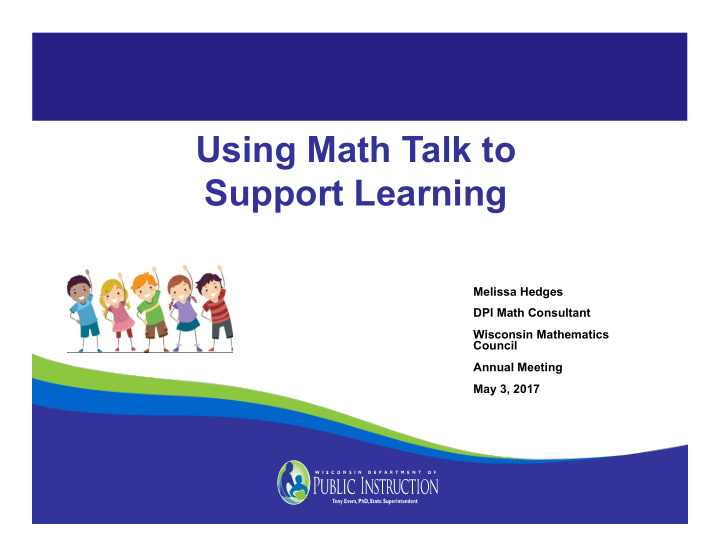



Using Math Talk to Support Learning Melissa Hedges DPI Math Consultant Wisconsin Mathematics Council Annual Meeting May 3, 2017
Agenda • Using Math Talk to Support Learning • Developing Math Talk Through Number Talks • Number Talks for Young Children
Learning Intentions We will … • Deepen our understanding of how math talk supports learning • Identify ways to intentionally plan for math talk during everyday activities. • Explore Number Talks as a more formal structure to support math reasoning and math talk.
Using Math Talk to Support Learning
Partner Check-in • What might math talk sound like in the preschool classroom? • When might math talk happen?
Some Examples of Math Talk “ You have 2 eyes and so does your bear. Let’s count: 1, 2” “I have more crackers than you do. See, I have three and you have two. I am going to eat one of mine. Now I have the same as you!” “That’s the third time I heard you say ‘mama.’ You said ‘mama’ three times!”
Using Talk to Support Math Learning h.ps://www.youtube.com/watch?v=TLmm3U0eYX4 When, and in what ways, does Ms. Dejesús use talk to capitalize on everyday opportunities to support math learning with her young students?
The Relationship of Teacher-Child Interactions In Preschool Play to Young Children’s Mathematical Ability Three Important Findings (1) Teacher-Child Interactions Around Number Sense: The more you talk about numbers with children in everyday contexts and settings, the more they learn about numbers. (connections between numbers and quantities) (2) Math Communication: Math talk, opportunities for children to share their reasoning out loud, is significantly important to young learners’ mathematical growth. (3) “Good fit” interactions during play. Teacher provides the “just right” amount of support that is aligned with what children are doing increases mathematical thinking. 2013 Center for Early Childhood Education at Eastern Connecticut State University http://www.easternct.edu/cece/math-play-video/
Being Intentional About Supporting Math Talk • Engage children in talk about numbers, counting, measurement, size, and shape throughout the day. • Find ways to encourage math talk in every center in the classroom. • Ask children to explain how they solved a math-related problem. • Encourage children to talk about their thinking when they make a mathematical mistake. Eastern ConnecJcut State University Dr. Jeffery Trawick-Smith and Dr. Sudha Swaminathan
The Cookie Game Materials • Counters “chips” • Plate • Paper circles or work mat of “Cookies” • Die Direc3ons Work in pairs. 1. Roll the die. 2. Put that number of chips on the plate. 3. Put chips on the cookies given the rule: “No more than 4 chips per cookie.”
Planning for Intentional Mathematical Learning While children play The Cookie Game, how might we as teachers: • Support number sense? • Encourage math talk? • Capitalize on “good-fit” interactions?
Intentional Teaching As we consider a renewed focus on the importance of communicating mathematical thinking with young learners … . What steps might we take as early childhood teachers to ensure an increased use of math talk with our children?
Number Talks: A Platform for Numerical Reasoning
What Are Number Talks? • Five- to fifteen-minute classroom conversations around purposefully crafted computation problems. • The problems in a number talk are designed to develop children’s number sense and fluency. • They are meant to be engaging and a fun! --Number Talks: Helping Children Build Mental Math and Computation Strategies , 2014, p. xx
Number Talk Norms • There are many ways to see, or do, any problem. • Everyone is responsible for communicating his or her thinking clearly so that others can understand. • Everyone is responsible for trying to understand other people’s thinking. --Humphreys & Parker, 2015, p. 14
How many dots are there? How do you know? 1. Discreet “thumbs up” when you know. 2. Use fingers to show how many different ways you know. 3. Be prepared to share with a partner.
Number Talks for Young Children
Number Talks for Young Children Focus on • deepening children’s understanding of quantity. • developing children’s number sense. • providing opportunities for children to share their thinking and reasoning out loud.
Finger Flash! Watch for my finger flash! • How many fingers do you see? • How do you know? h.ps://www.youtube.com/watch?v=8sHpKd_Rx5A
Encouraging Children to Talk SuggesJon: Start with an image and ask children to explain their thinking. How many do you see? How do you know?
Predict with your partner how the children in Ms. Keenan’s class might explain how many dots they see? How are the tools and models Used to support math talk? How does the teacher support math talk?
Interested in learning more? Book: Number Talks: Helping Children Build Mental Math and Computation Strategies By Sherry Parrish
Interested in learning more? h.p://mathperspecJves.com/number-talks/
Interested in learning more? Oakland Elementary School McDonough GA h.p://schoolwires.henry.k12.ga.us/Page/ 73087
Learning Intentions We will … • Deepen our understanding of how math talk supports learning • Identify how we might engage children in math talk during everyday activities. • Explore Number Talks as a more formal structure to support math reasoning and math talk.
Recommend
More recommend